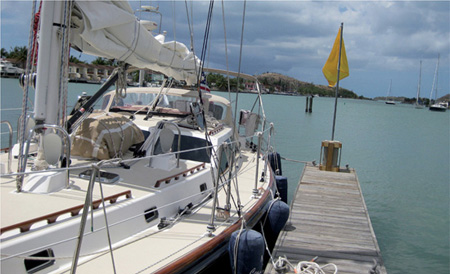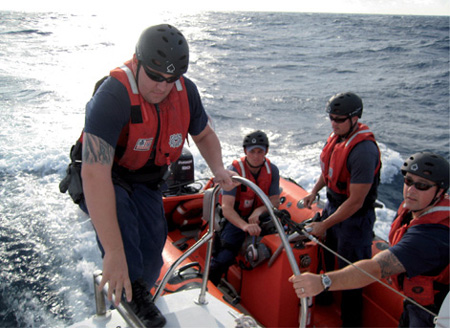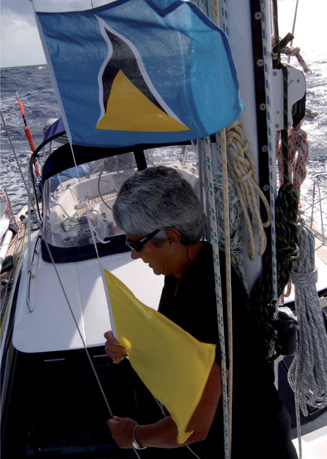
Customs and Immigration regulations, and the formality with which they are applied, vary from country to country. In some areas, a yacht entering a remote harbour or anchorage may be treated with suspicion. To allay these fears, always contact the authorities on arrival, even if only the local police.
There is a universal ban on the import of hard drugs, and many countries look carefully at prescribed medicines which should be accompanied by a letter from the prescribing doctor. Import of fresh meat is forbidden in some countries, as are growing plants and some fresh vegetables. Many countries place restrictions on the import of alcohol and tobacco. All firearms, including flare guns, must be declared and failure to do so will incur very heavy penalties, particularly in the United Kingdom. In the United Kingdom and Irish Republic there are very strict regulations regarding bringing live animals of any kind into the country. If you have pets on board it is essential that you contact the authorities at your intended port of arrival well in advance. The anti-rabies laws are taken very seriously indeed. Animals must be micro-chipped, and you must carry all the relevant documentation to show that the appropriate vaccinations have been given to your animal.
Be aware of the Convention on International Trade of Endangered Species of Wild Flora and Fauna (CITES). Seemingly innocent collections of empty shells or pieces of already broken coral from remote beaches may get you into trouble and make you liable for a fine. If you buy shells, for example turtle shell from a licensed turtle farm, ensure that you have the appropriate certification. Cruisers have been caught out in the past when they have flown home with collected treasures such as Queen Conch shells, only to find them confiscated and a heavy fine imposed. The same may be true on arrival at any port of entry.

Clearing in on the Customs’ dock at Jolly Harbour, Antigua. In many ports of call it is more usual to go ashore by dinghy to clear in or out. Photo Graham Adam
A stamp with boat name, port of registry and call sign used to be a necessary piece of onboard equipment. Few port officials now ask for papers to be stamped, although in Morocco and West African ports, a ships stamp may ease the path through officialdom. A more useful item is a boat’s ‘business card’ with boat name, home port, registration number and radio call sign, plus the skipper’s or owner’s mailing address and e-mail address. Small adhesive address stickers are a basic alternative. These are also useful for entries in the visitors’ books which are carried by many cruising yachts.
If you are entering a new country you will need to check in at a Port of Entry. Some suggested Ports of Entry are indicated in Part II. Familiarise yourself with the entry procedures before arrival. As procedures do vary, the easiest way to do this is to talk to other yachts which have already arrived. Hoist the national ensign if it has not been worn at sea, and have both the Q flag and a courtesy ensign ready to hoist on entering territorial waters. Not surprisingly, yachts flying an incorrect, tattered or upside-down courtesy ensign will be disapproved of. Establish whether it is necessary to report to the authorities by radio before entering the harbour. In most places the skipper (with or without the First Mate) should go ashore to report as soon as the yacht is secured, but occasionally all the crew are required to remain on board until the officials visit. In the USA all the crew now have to be fingerprinted, which is usually done ashore. If you are unsure about procedures, another yacht in the anchorage may be able to advise. In some places you will be charged extra for checking in outside office hours. However, a delay in going ashore to check in may make you liable for a fine. Harbour launches sometimes monitor any anchorages close to the check-in port on a regular basis, so you should not assume that your entry has gone unnoticed while you wait for office hours.
Any new country that you arrive in will be well aware that you are visiting for pleasure, and you are likely to be welcomed with courtesy if not outright warmth. Checking in can be time consuming, but if you have all your necessary paperwork to hand and remain pleasant and patient with all the officials you may find that things go more easily. Collect all the documents needed and make out a crew list with full names, dates and places of birth, and passport numbers. It is useful to have photocopies of a blank or partially complete crew list form which you can fill in with updated details. Alternatively you can generate a crew list on the computer and print out copies as required. Different countries demand different information, and many insist that the details should be written on their own printed forms.
Apart from the documents, in many places procedures will take less time if you take your own pen, a supply of carbon paper, some blank paper for making notes and a phrase book if applicable. Having some cash in the local currency is helpful, but US dollars are usually acceptable and occasionally preferred. Some ports of entry have cash machines within the harbour compound.

Being boarded at sea by the Coast Guard can be an alarming experience. Put out lots of fenders and manoeuvre as directed. Photo: Richard Woods
There are several Ports of Entry where officials may choose to visit you on board. In some countries the officials may carry firearms. There are also occasions when you might be boarded at sea whilst on passage, particularly on approach to a landfall. This can be quite a frightening experience, particularly at night. If you are at all unsure of the identity of an approaching vessel, call them up on the VHF and ask them to identify themselves. If they do not respond and it is dark, a strong flashlight shone downwards towards their hull – not in their eyes – should reveal any Coast Guard or similar livery. If the approaching vessel shines a light on you, make it clear that you would like to talk to them on the VHF. Try to ascertain whether they require you to heave-to or stop your engine, or whether they wish you to proceed slowly on a fixed course. Put out lots of fenders. Their behaviour may seem disproportionate and heavy-handed but, if they are involved in an effort to restrict trafficking of any sort, their modus operandi will tend to assume that you may be carrying weapons on board. They may wish to search the whole vessel and they will probably separate crew members for individual questioning. Try to stay calm, and be helpful with any documentation they may want to see. Depending on the prevailing weather conditions they may require you to put into a nearby port.
The appropriate courtesy flags for each country are shown beside the chapter headings in Part II. Some people choose to buy a set of courtesy flags, others take appropriate materials to make their own. Some of the flags have complicated designs which make sewing them quite a challenge. An alternative is to take sufficient white cloth – off-cuts of sail cloth are good – and a range of acrylic paints and paint brushes. You can then accurately reproduce the flag.

Flying courtesy and Q flags as you approach a Port of Entry will get you off to a good start with the officials. Photo: Mike Robinson
Cash machines (ATMs) are found worldwide, and it is usually a very straightforward process to access local currency on arrival in a new country. Just be sure that you do not forget your PIN numbers and ensure that your cards will remain in date for the duration of the cruise. Managing your funds will be up to you, but using a credit card to obtain cash is often considerably more expensive than using a debit card. Different cards are linked to different networks, for example MasterCard or Visa. Although both systems are widely available, it is sensible to carry cards of both types. Don’t keep all your cards together in one place, so that any loss or theft will not be completely disastrous. Obtaining replacement cards abroad can be a complicated process. If losing your card in a machine worries you, most banks will allow you to use cards to obtain cash over the counter as long as you have a passport for identification.
It is useful to carry a small reserve of cash on board. Small denomination euros and US dollars are the most useful. Some yachts carry a larger concealed reserve of cash in case of emergency. If deciding to do this, the cash should be split into reasonable-sized amounts and hidden separately. Never tell anyone where this cash is hidden, or even that it is aboard.
Many countries allow yacht equipment or spares for a visiting foreign yacht to be imported duty free. It is always wise to enquire about current regulations concerning paperwork, labelling and notification before such equipment is dispatched. Parcels should be clearly labelled ‘FOR VESSEL IN TRANSIT’ (unless other wording is specified locally). Personal imports are nearly always subject to duty.
Third-party insurance is relatively inexpensive and is recommended as a minimum on an Atlantic cruise. The risk of a third-party claim against you is not worth taking. Some harbours and marinas will not allow entry to uninsured vessels. It is sometimes difficult for yachts sailed by two or even three people to get comprehensive insurance, and the benefits of having such cover may have to be balanced against the undesirability of being forced to carry extra crew. Companies are much more likely to provide cover if they have confidence in you. This may come from a shared insurance history, for example if your boat has been insured with a company for several years already, or from current evidence that you and the boat are well prepared. Willingness to accept a high excess (deductible) will demonstrate that trivial claims are not being contemplated. Apart from the more obvious hurricane issues, insurance cover in other areas such as Biscay may come with strings attached, regarding timing or crew numbers, so plan well ahead. It will always be difficult to obtain insurance cover for the Caribbean during the hurricane season, but you should consider carefully the reasons for this before deciding to keep a boat there during that period.
A standard medical insurance policy may not protect you while cruising, and you should make amendments if necessary. Europeans should obtain a European Health Insurance Card, which entitles them to free, or reduced-cost, emergency treatment in EU countries. The French islands are part of the EU. Private medical fees are high in the West Indies and the United States compared with Europe, though many West Indian islands have free health schemes based on the UK National Health model, and in some islands reciprocal arrangements for free treatment have been established with the United Kingdom and with some other EU countries. Medical attention in the United States is very much more likely to be prompt if evidence of US-valid medical insurance is produced at the outset.
In many areas where shipping is heavy – particularly around headlands, where a number of major routes converge, and in constricted waters – IMCO Traffic Separation Schemes (TSS) have been set up. Typically they consist of two lanes down which vessels pass port-to-port, a central separation zone, and usually an inshore traffic zone. The rules governing separation schemes are detailed in the International Regulations for Preventing Collisions at Sea, but as far as yachts are concerned the most important points are as follows:

Insurance-approved storage for use during the hurricane season at Marina del Rey, Puerto Rico. Photo: Marina del Rey
1 As far as possible, avoid crossing traffic lanes, but if obliged to do so, cross on a heading as nearly as practicable at right angles to the general direction of traffic flow. (It should be noted that it is the heading rather than the ground track that is to be at right angles to the traffic flow.)
2 Use inshore traffic zones whenever possible.
3 Do not impede the safe passage of a power-driven vessel following a traffic lane.
Traffic Separation Schemes are often monitored by Coast Guards or other official bodies, usually by radar, and sailors have been prosecuted for ignoring the regulations. The Traffic Separation Schemes that yachts might encounter going across the Atlantic are: off Lands End, off Ouessant, off the north-west corner of Spain, off Cape St Vincent, in the Gibraltar Straits, around Cuba, and the many along the east coast of the United States and Canada.